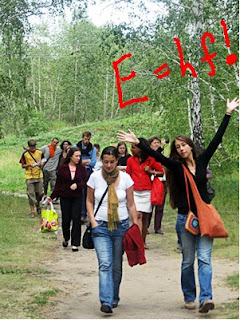I cover the bare-bones basics of observational astronomy. This includes the motions of the earth and moon; apparent motion of the stars; and some “how do we know that” questions (like, the use of parallax to find the distance to nearby stars).
Why is astronomy so difficult? I don’t know. I know that elementary school teachers generally show the geometry behind eclipses and the phases of the moon. Yet, most of my class will say that the earth’s shadow is responsible for moon phases, and cannot reliably discuss the reason that we don’t have an eclipse every month. Similarly, I know that someone has taught my juniors and seniors why seasons occur… nonetheless, they invariably tell me that the earth is closer to the sun in the summertime.
What’s embarrassing and frustrating is that many of my students maintain these misconceptions EVEN AFTER we have discussed them repeatedly in class.
Anyway.
In class, I have a copy of the astronomical simulation program Starry Night Backyard, a globe, and a few scanned diagrams from a college introductory astronomy textbook. I have a general plan as to what I want to cover, but I also let the discussion follow student interest – I get more curiosity-inspired questions in this unit than in any other.
However, it is imperative that I keep students focused on the class discussion. If I’m not careful, I end up answering a good question for one student while the others fall asleep in the warm, dark, room as they dream of summer vacation and bikini-clad women. What do I do?
I assign a couple of questions for homework each night – each night’s assignment is designed to take about 30 minutes. Then, the next day, I give a 5-7 question multiple choice quiz. The quiz is partly based on the homework, and partly based on discussions from the previous day’s class. Students learn quickly that they are, in fact, responsible for everything that goes on in class.
As an extra reward, I give any student with a perfect score on a quiz a homework exemption, to use whenever he wants. (I discuss the use of exemptions in my April 24 post.) The combination of the quiz grade, the required homework, and the possibility of an exemption tends to hold student interest.
Below is a sample assignment and quiz. I can post more of these if people are interested – tell me what you’re looking for in a comment or an email.
GCJ
Assignment:
1. The radius of the earth is 6400 km; the radius of the sun is 700,000 km. Watch your significant figures carefully – note that we are looking for power of ten estimates only!
a. The diameter of the sun is how many times bigger than the diameter of the earth?
b. How many Earths could fit inside the sun? (Note that the answer to (b) is NOT the same as the answer to (a).)
c. Look up the mass of the sun and of the earth. How many times more massive is the sun?
2. Which is more dense, the earth or the sun?
a. First, answer based on what you already know or what you can look up online.
b. Next, answer based on your response to questions 1b and 1c above.
Follow-up quiz:
How much closer is the earth to the sun during our summertime than during our wintertime?
(A) About 3% closer
(B) About 30% closer
(C) About 3 times (300%) closer
(D) None of the above, the earth is actually farther away from the sun in summer.
On which of the following dates is the sun directly overhead at noon at the equator?
(A) June 22
(B) September 22
(C) December 22
(D) None of the above because the sun is never directly overhead at the equator
(E) None of the above because the sun is always directly overhead at the equator
On which of the following dates is the sun directly overhead at noon at Woodberry Forest?
(A) June 22
(B) September 22
(C) December 22
(D) None of the above because the sun is never directly overhead at Woodberry
(E) None of the above because the sun is always directly overhead at Woodberry
How many earths could fit inside the sun?
(A) A hundred
(B) A thousand
(C) A hundred thousand
(D) A million
(E) Ten million
How many times bigger than the earth’s diameter is the sun’s diameter?
(A) A hundred
(B) A thousand
(C) A hundred thousand
(D) A million
(E) Ten million




 (c) Which of the following expressions represents the net force on the right-hand block on the flat surface above? Choose one and explain
(c) Which of the following expressions represents the net force on the right-hand block on the flat surface above? Choose one and explain (d) Where is the pressure in this fluid stream largest? Choose one.
(d) Where is the pressure in this fluid stream largest? Choose one.




